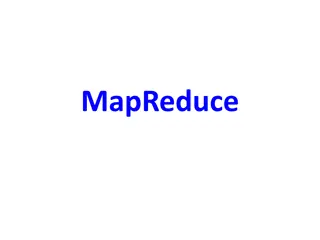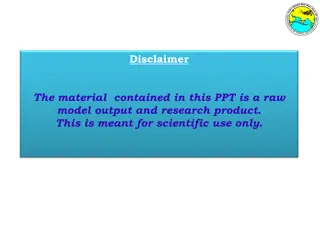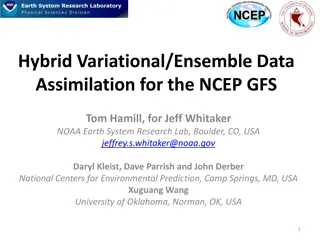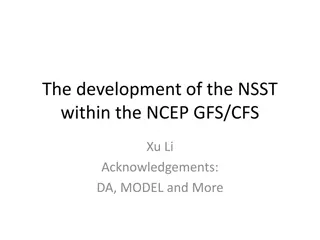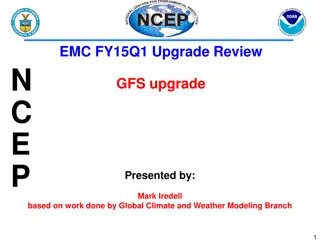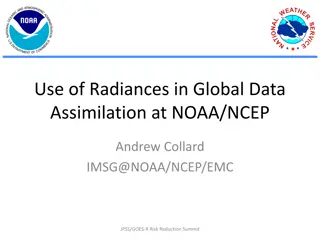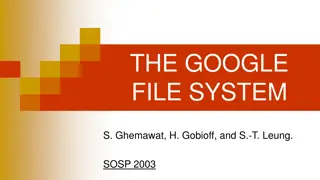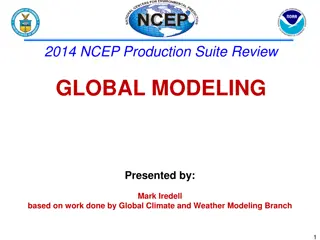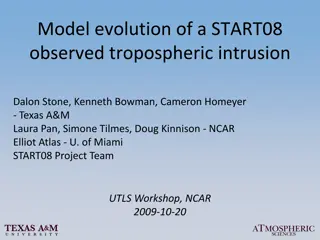Understanding MapReduce and Hadoop: Processing Big Data Efficiently
MapReduce is a powerful model for processing massive amounts of data in parallel through distributed systems like Apache Hadoop. This technology, popularized by Google, enables automatic parallelization and fault tolerance, allowing for efficient data processing at scale. Learn about the motivation
2 views • 33 slides
Experimental Lightning Flash Prediction Based on Real-Time Forecast
This PowerPoint presentation provides real-time experimental lightning flash prediction based on initial conditions data from GFS and WRF models. The forecast covers Day 1 and Day 2 with detailed insights on 24-hour accumulated total lightning flash counts and 3-hourly accumulated total lightning fl
0 views • 8 slides
Hybrid Variational/Ensemble Data Assimilation for NCEP GFS
Hybrid Variational/Ensemble Data Assimilation combines features from the Ensemble Kalman Filter and Variational assimilation methods to improve the NCEP Global Forecast System. It incorporates ensemble perturbations into the variational cost function, leading to more accurate forecasts. The approach
0 views • 22 slides
Understanding Near-Surface Sea Temperature Development in NCEP GFS/CFS
This informative piece delves into the evolution of Near-Surface Sea Temperature (NSST) within the NCEP GFS/CFS, discussing its significance in Numerical Weather Prediction (NWP) systems, the utilization of sea surface temperature (SST), and the T-profile near the sea surface. It covers the role of
0 views • 28 slides
EMC FY15Q1 Upgrade Review for GFS System
Upgrade review presented by Mark Iredell on the planned system changes and expected benefits for the Global Forecast System (GFS) in December 2014. Highlights include enhancements to modeling capabilities, forecast accuracy, and system optimizations across various components like analysis, model dyn
0 views • 28 slides
Overview of Wide Area Storage Systems
Wide Area Storage Systems play a crucial role in addressing the challenges faced by modern web-scale applications with geographically distributed users. This overview discusses key concepts such as GFS, Bigtable, Sinfonia, Calvin, and solutions involving multiple data centers across regions to enhan
0 views • 22 slides
Advances in Global Data Assimilation at NOAA/NCEP: Radiance Data and Future Developments
Explore the utilization of radiance data in global data assimilation at NOAA/NCEP, focusing on the integration of various satellite instruments like AMSU-A, ATMS, MHS, and more. Recent and upcoming enhancements to the global data assimilation system are discussed, with an emphasis on changes to the
0 views • 5 slides
Understanding The Google File System (GFS)
The Google File System (GFS) introduced in 2003 by Ghemawat, Gobioff, and Leung, is designed for an unusual environment where component failures are common. GFS is specifically tailored for storing large files with primarily read-heavy workloads, emphasizing high sustained bandwidth over low latency
0 views • 33 slides
Overview of Cluster Storage Systems
Web-scale applications hosted in massive computing infrastructures require scalable storage systems. This overview covers different types of storage systems, including file systems and databases, emphasizing the key design ideas and pros/cons of Google File System (GFS).
0 views • 17 slides
Overview of 2014 NCEP Production Suite Review on Global Modeling
The 2014 NCEP Production Suite Review highlighted the significant implementation of the 13 km Global Forecast System (GFS). This major update involved substantial enhancements in resolution, observations, analysis, and physics, impacting various NCEP models and centers. The improved 13 km GFS brough
0 views • 20 slides
Analysis of Tropospheric Intrusion Evolution in START08 Field Campaign
The study presents the analysis of tropospheric intrusion evolution during the START08 Field Campaign using models such as WACCM and GFS. The primary goals include comparing model output with observations, verifying dynamical transport features, and studying the spatial and temporal evolution of mid
0 views • 26 slides
